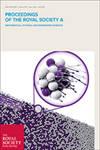Review Paper. Characterization and stability of two–phase piecewise–homogeneous deformations
Proceedings of the Royal Society of London. Series A. Mathematical and Physical Sciences
Pub Date : 2004-11-08
DOI:10.1098/rspa.2004.1361
引用次数: 48
Abstract
Many solid materials exhibit stress–induced phase transformations. Such phenomena can be modelled with the aid of the nonlinear elasticity theory with appropriate choices of the strain–energy function. It is known that if a two–phase deformation (with gradient F) in a finite elastic body is a local energy minimizer, then given any point p of the surface of discontinuity, the piecewise–homogeneous deformation corresponding to the two values F±(p) of F(p) is a global energy minimizer. Thus, instability of the latter state would imply instability of the former state. In this paper we investigate the stability properties of such piecewise–homogeneous deformations. More precisely, we are concerned with two joined half–spaces that correspond to two different phases of the same material. We first show how such a two–phase deformation can be constructed. Then the stability of the piecewise–homogeneous deformation is investigated with the aid of two test criteria. One is a kinetic stability criterion based on a quasi–static approach and on the growth/decay behaviour of the interface in the undeformed configuration when it is perturbed; the other, referred to as the energy criterion, is used to determine whether the deformation is a minimizer of the total energy with respect to perturbations of the interface in both the current and undeformed configurations. We clarify the differences between the two criteria, and provide a compact formula which can be used to establish the stability/instability of any two–phase piecewise–homogeneous deformations.评审论文。两相分段均匀变形的表征与稳定性
许多固体材料表现出应力引起的相变。这种现象可以借助非线性弹性理论进行建模,并适当选择应变-能函数。已知,如果有限弹性体的两相变形(梯度为F)是局部能量最小值,则给定不连续曲面的任意点p,则F(p)的两个值F±(p)对应的分段均匀变形是全局能量最小值。因此,后一种状态的不稳定意味着前一种状态的不稳定。本文研究了这类分段均匀变形的稳定性。更准确地说,我们关注的是两个连接在一起的半空间,它们对应于同一材料的两个不同相。我们首先展示了如何构造这样的两相变形。在此基础上,采用两种试验准则对分段均匀变形的稳定性进行了研究。一种是基于准静态方法的动力学稳定性判据,该判据基于受扰动时界面在未变形构型中的生长/衰减行为;另一种称为能量准则,用于确定在当前和未变形构型中,相对于界面的扰动,变形是否是总能量的最小值。我们澄清了两个标准之间的差异,并提供了一个紧凑的公式,可用于建立任何两相分段均匀变形的稳定性/不稳定性。
本文章由计算机程序翻译,如有差异,请以英文原文为准。
求助全文
约1分钟内获得全文
求助全文
来源期刊
自引率
0.00%
发文量
0
期刊介绍:
Proceedings A publishes articles across the chemical, computational, Earth, engineering, mathematical, and physical sciences. The articles published are high-quality, original, fundamental articles of interest to a wide range of scientists, and often have long citation half-lives. As well as established disciplines, we encourage emerging and interdisciplinary areas.

 求助内容:
求助内容: 应助结果提醒方式:
应助结果提醒方式:


